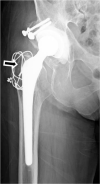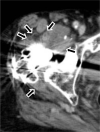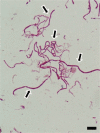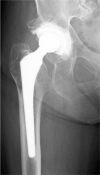Prosthetic joint infection after total hip arthroplasty caused by Sneathia sanguinegens: A case report (CARE-complaint)
- PMID: 33031285
- PMCID: PMC7544305
- DOI: 10.1097/MD.0000000000022494
Prosthetic joint infection after total hip arthroplasty caused by Sneathia sanguinegens: A case report (CARE-complaint)
Abstract
Introduction: Sneathia sanguinegens(S sanguinegens) is a gram-negative rod-shaped bacterium mostly reported to cause a perinatal infection, and there are no reports of S sanguinegens in prosthetic joint infection (PJI). The purpose of this report is to describe a very rare case of PJI after total hip arthroplasty (THA) caused by S sanguinegens.
Patient concerns: A 79-year-old woman presented with right coxalgia, inability to walk, and a fever of 39°C. She had undergone THA 28 years earlier for osteoarthritis of the hip.
Diagnoses: The diagnosis was acute late-onset PJI, because blood tests revealed marked inflammatory reaction and computed tomography showed an abscess at the right hip joint; synovial fluid analysis resulted in detection of a gram-negative bacillus.
Intervention: Surgical debridement with retention of the implant and antibiotic therapy was performed.
Outcomes: One month after surgery, polymerase chain reaction (PCR) assay showed that the pathogen was 99.9% likely to be S sanguinegens. There has been no recurrence of infection or loosening of the implant in the 2 years since her surgery.
Lessons: PCR should facilitate detection of previously unknown pathogens and potentially novel bacterial species.
Figures





Similar articles
-
Septic arthritis due to a Sneathia species most closely related to Sneathia sanguinegens.J Med Microbiol. 2011 Nov;60(Pt 11):1693-1696. doi: 10.1099/jmm.0.027458-0. Epub 2011 Jul 7. J Med Microbiol. 2011. PMID: 21737545
-
Identifying Common Pathogens in Periprosthetic Joint Infection and Testing Drug-resistance Rate for Different Antibiotics: A Prospective, Single Center Study in Beijing.Orthop Surg. 2018 Aug;10(3):235-240. doi: 10.1111/os.12394. Orthop Surg. 2018. PMID: 30152610 Free PMC article.
-
A spacer infection by Candida albicans secondary to a Staphylococcus capitis prosthetic joint infection: a case report.BMC Infect Dis. 2021 May 4;21(1):416. doi: 10.1186/s12879-021-06113-8. BMC Infect Dis. 2021. PMID: 33947342 Free PMC article.
-
Sonication contribution to identifying prosthetic joint infection with Ralstonia pickettii: a case report and review of the literature.BMC Musculoskelet Disord. 2017 Jul 19;18(1):311. doi: 10.1186/s12891-017-1678-y. BMC Musculoskelet Disord. 2017. PMID: 28724376 Free PMC article. Review.
-
Prosthetic hip infection due to Brucella melitensis: case report and literature review.Diagn Microbiol Infect Dis. 2007 Aug;58(4):481-5. doi: 10.1016/j.diagmicrobio.2007.03.013. Epub 2007 May 16. Diagn Microbiol Infect Dis. 2007. PMID: 17509788 Review.
Cited by
-
Two Stage Revision Total Hip Arthroplasty for Enterobacter Induced Periprosthetic Joint Infection in an Elderly Female: A Case Report.J Orthop Case Rep. 2024 Nov;14(11):103-109. doi: 10.13107/jocr.2024.v14.i11.4930. J Orthop Case Rep. 2024. PMID: 39524281 Free PMC article.
References
-
- AlBuhairan B, Hind D, Hutchinson A. Antibiotic prophylaxis for wound infections in total joint arthroplasty. J Bone Joint Surg 2008;90:915–9. - PubMed
-
- Triantafyllopoulos GK, Soranoglou VG, Memtsoudis SG, et al. . Rate and risk factors for periprosthetic joint infection among 36494 primary total hip arthroplasties. J Arthroplasty 2018;33:1166–70. - PubMed
-
- Hanff PA, Rosol-Donoghue JA, Spiegel CA, et al. . Leptotrichia sanguinegens sp. nov., a new agent of postpartum and neonatal bacteremia. Clin Infect Dis 1995;20: (suppl 2): S237–9. - PubMed
-
- Collins MD, Hoyles L, Tornqvist E, et al. . Characterization of some strains from human clinical sources which resemble “Leptotrichia sanguinegens”: description of Sneathia sanguinegens sp. nov., gen. nov. Syst Appl Microbiol 2001;24:358–61. - PubMed
Publication types
MeSH terms
Substances
Supplementary concepts
LinkOut - more resources
Full Text Sources

